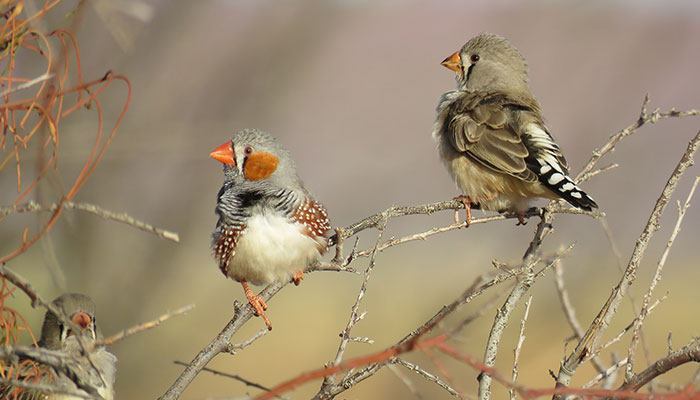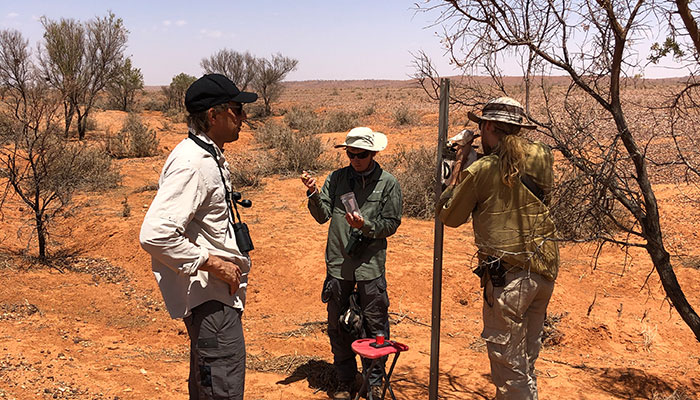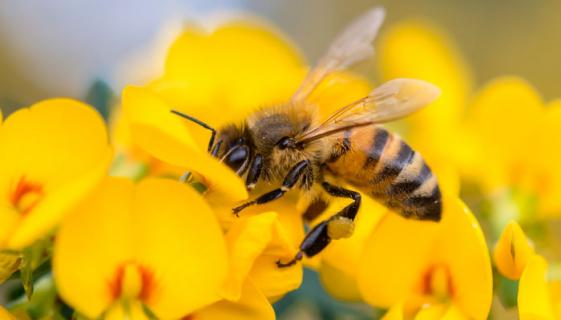In its natural desert habitat, the tiny, colourful Australian zebra finch sings all year round, and their song helps them to communicate with their flock and their mate, as well as synchronise breeding.

Five years: Professor Griffith's findings are the result of five year analysis of recordings of zebra finch song in their natural habitat in an Australian arid zone. Image credit: Simon Griffiths
Song plays a different role in these wild finches than that observed in many other songbirds where song is primarily used to establish territory and attract a mate, according to a new study co-authored by Macquarie University behavioural ecologist, Professor Simon Griffith.
The research, published today in the Journal of Current Biology, used five years of field studies at an arid zone research station (which included year-round audio recordings) to understand the times, environmental conditions and social settings where zebra finches sing.
“The zebra finch is one of the world’s most-researched bird species, because they thrive in captivity, and birdsong in general has been studied for hundreds of years – but this study includes blue-sky research that re-interprets the role of birdsong,” says Griffith.
Analysis of recordings of zebra finch song in their natural habitat ... found that male zebra finches would sing together in groups, and would also sing when alone with their partners.
Most theories around birdsong emerged from continental Europe and North America which biased research towards song patterns during short and competitive seasonal breeding cycles, he says.
“Birds in those parts of the world typically don't sing much in winter, but in spring, there’s a noticeable explosion of birdsong – but birds in other parts of the world – such as magpies in Australia’s tropical and temperate climates - will sing throughout the year,” he says.
Love songs of the zebra finch
Analysis of recordings of zebra finch song in their natural habitat, made by automated recorders, found that male zebra finches would sing together in groups, and would also sing when alone with their partners.
Griffith says that the study was an international collaboration led by Hugo Loning from Wageningen University in the Netherlands.
Studies on the development of the brain and genetics have focused on understanding how male birds learn and produce their songs, and how female birds are able to listen to and discriminate between different males' songs.
“The male zebra finch learns its song during a brief window of development and continues to sing the same song for the rest of its life,” Griffith says – adding that females can distinguish their partner's song from those of other males in the local area.
Zebra finch pairs form long-term monogamous bonds early in life – and Griffith says that the singing may also serve as a form of ongoing conversation between the pair about local conditions and their readiness to breed.
“Most of the male’s singing happens after he's paired, and often he'll sit right next to his female, in the same bush, oriented towards her, just singing away,” he says.
“We believe is this is how he signals information about their environment and whether there's enough food for them to start breeding and rearing their offspring.”
Choir of Zebra Finches
The researchers found that the rate of singing in a group of finches would increase as conditions improved and breeding season approached, possibly signalling to other birds in about the conditions to synchronize their breeding activity.

Fieldwork: Macquarie University behavioural ecologist Professor Simon Griffith worked with international researchers in a team led by Hugo Loning from Wageningen University, pictured, in the Netherlands. Image credit: Simon Griffiths Location: UNSW Fowlers Gap Arid Zone Research station, 110km north of Broken Hill in far west NSW.
This can be particularly important for Australian birds, which have longer and more variable breeding seasons compared to birds in Europe.
Griffith adds that the singing helps to enhance social cohesion – and also allows flocks to synchronise their breeding to suit local conditions, which can vary over the long breeding season in an arid climate.
They found that the birds continued to sing even during times of drought, suggesting that singing is not just related to breeding and choosing mates.
- Greenwashing in the firing line as Australian super funds pursue authentic sustainability
- Netflix review: Why we'll take Wednesday every day of the week
Song analysis also found that multiple males will sing from the same location and at the same time, indicating a social aspect to the singing.
The researchers also conducted playback experiments to test how the birds respond to song, and found the birds were more likely to approach the recording site or to sing in response to the sound of other zebra finches, compared to a control playback of nightingale song.
Griffith says that by following birds and their songs in their natural habitat, this research shows that the birdsong has important functions beyond territoriality and mate choice, and plays a role in coordinating and strengthening social cohesion.

Simon Griffith , pictured, is a Professor in the School of Natural Sciences in the Faculty of Science and Engineering.
The study was an international collaboration led by Hugo Loning from Wageningen University in the Netherlands, with funding from the Netherlands Organization for Scientific Research.



